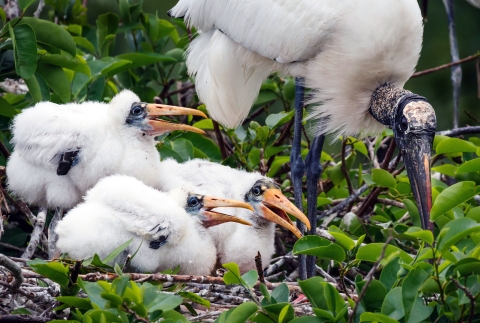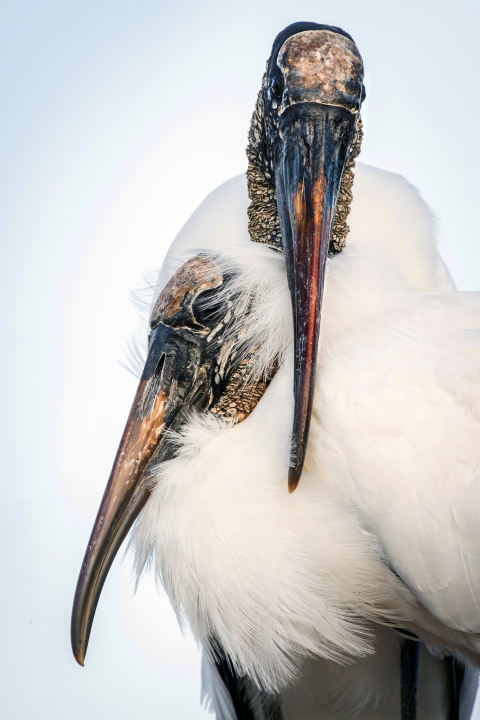Identifying Features
The wood stork (Mycteria americana) is North America’s only native stork species. Standing about three feet tall with a wingspan of five feet or more, this large wading bird is unmistakable. Adults have bright white plumage, contrasted by black flight feathers that are most noticeable in flight. Perhaps their most distinguishing feature is their featherless, scaly-looking head and neck with a thick, downturned bill, giving them an ancient, almost prehistoric appearance. Young wood storks lose the feathers on their head and neck during years 1 and 2, and also have pale, yellow bills which darken as they mature.
Where to Find Them
Wood storks are dependent upon wetland habitats and can be found in several national wildlife refuges throughout the Southeastern United States. Prime locations to spot these birds include:
- Harris Neck National Wildlife Refuge (GA): A key nesting site for wood storks, offering excellent viewing opportunities during the breeding season.
- St. Marks National Wildlife Refuge (FL): A prime wintering site with a mix of freshwater and brackish wetlands.
- Okefenokee National Wildlife Refuge (GA): A vast swamp ecosystem where wood storks can be seen foraging in shallow waters.
- Merritt Island National Wildlife Refuge (FL): The refuge's coastal location, tropical climate, and wide variety of habitat types contribute to its diverse bird population. To date, 357 species have been identified on the refuge.
J.N. “Ding” Darling National Wildlife Refuge (FL): Located on the subtropical barrier island of Sanibel, this refuge is part of the largest undeveloped mangrove ecosystem in the United States. It is world famous for spectacular migratory bird populations.
Ernest F. Hollings Ace Basin National Wildlife Refuge (SC): Steeped in cultural history and natural resources, this refuge is located within the larger 350,000-acre Ashepoo-Combahee-Edisto (ACE) Basin System, which represents one of the largest undeveloped wetland ecosystems remaining on the Atlantic Coast.
Cape Romain National Wildlife Refuge (SC): Extending 22 miles along the South Carolina Coast, this refuge is a rich mosaic of barrier islands with forest and ponds, vast salt marshes and intricate waterways.
What makes these birds special?
Spotting a wood stork is a rewarding experience, as their presence is a testament to healthy wetland ecosystems. This species was originally listed as endangered in 1984 due to habitat loss and declining populations. During the last 30 years, conservation efforts, including the protection of wetlands and the restoration of large wetland ecosystems critical to nesting, helped them grow and expand their breeding range. In 2014 the species was reclassified from endangered to threatened, marking a significant success in avian conservation. Another success came in 2023, when the Service proposed to delist the wood stork due to recovery. Wood storks remain vulnerable to environmental changes, particularly the alteration and destruction of wetlands, which underscores the need for continued conservation work.
Wood Stork Photo Contest
As part of our Bird of the Month series, we invite you to submit your photos of wood storks in a photo contest.
**In the file name of your photo, please include your first and last name, contact email address, and the location where the photo was taken. If these components are missing, we will have no way of contacting you if you win.**
Submissions will be judged by a panel of U.S. Fish and Wildlife Service employees. Once a winner is selected, they will be contacted via email and asked to sign a photo release form. This form protects the photographer's rights, ensures proper credits are given, and grants the U.S. Fish and Wildlife Service permission to share the photo on our social media channels. Please monitor your junk/spam folders towards the end of the month in the event that we reach out and our email lands there.
Need some tips on bird photography? Look no further!
The winner will be announced publicly near the end of each month on our Southeast Regional Facebook and X (formerly known as Twitter) platforms.
A photo contest will occur each month for each featured bird species. At the end of 2025, all twelve winning photographs will be shared on our regional social media accounts.









